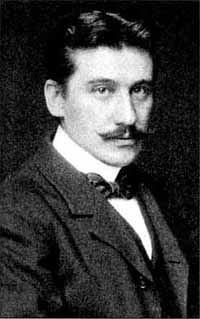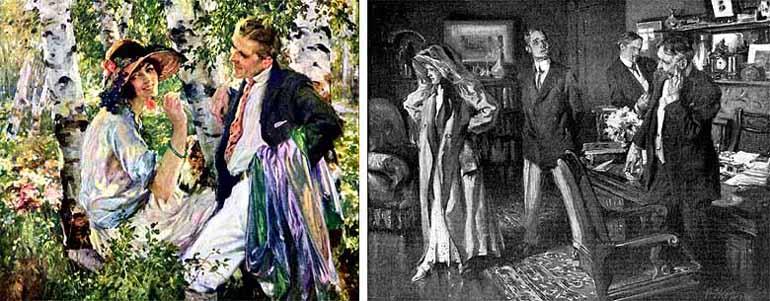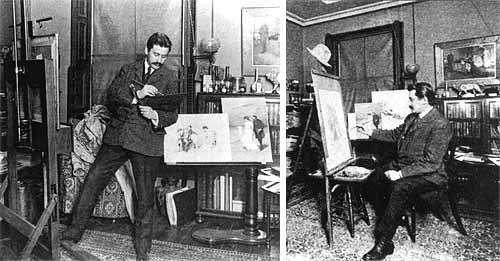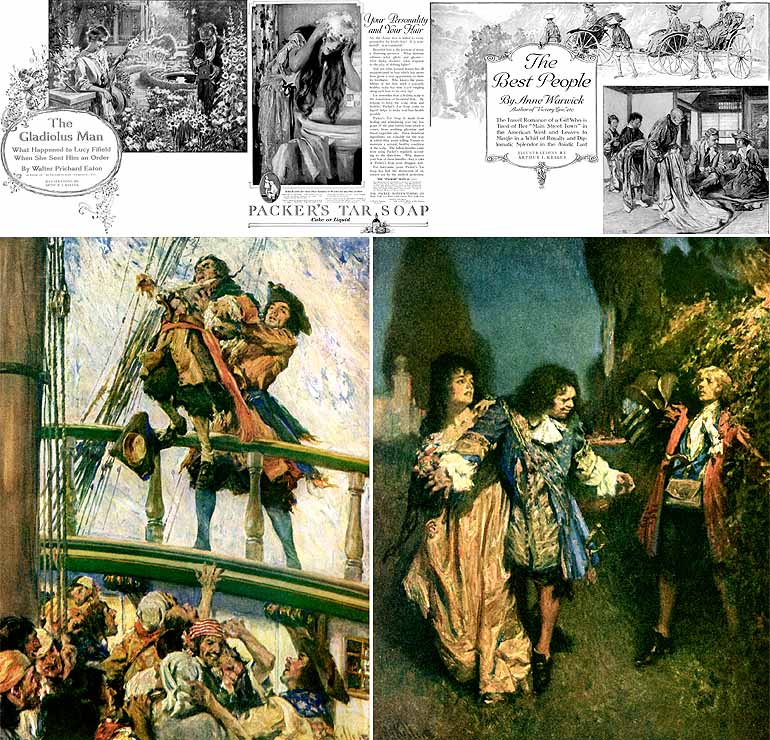
|
Copyrighted Material -CLICK for information |
|
Back |
 |
Arthur Ignatius Keller
(1866 - 1924) By Sally Howell Matz (granddaughter of A I Keller) by permission |

Photo of artist (???) Keller - 001 |
|
The Artist Before leaving Munich, Keller received the Hallgarten Prize, and his painting “At Mass” was purchased by the Academy. Unfortunately, this painting was destroyed during an Allied bombing raid in WW II. Regarding Keller the artist, critic Walter Jack Duncan writes: “Keller, was a born artist. By instinct we recognize this at once. His simplest sketch, every stroke of his brush or pencil, is nervous with artistic energy. One feels it pulsating sturdily through all his multifarious work, through his graceful and sinuous drawings, his exquisite watercolors, his crowded and animated oils. His preliminary sketches especially, so fluent, natural, unaffected, flowing straight out of his facile pencil and confessing all it is possible to know of an artist’s talent, prove beyond question that here was a man who was an artist in the full meaning of the word; as the actors used to say, an artist to the fingertips.” Keller, in one of his weekly letters to his family, provides some insights into the style and techniques he was striving to achieve: “My Professor wants me to get more solidity and force in my next study and leave charm and poetry to do its work unconsciously.” He continues with a boastful description of one of his works, “the study had an unquestionable magnetism, everybody who stayed around it, so much enjoyed telling me how successful I had been. The quality of the painting that is most successful is the color. What I am striving for is tone, simplicity and easy harmony of color. |

Ladies' Home Journal, "His Name was Jonah," (1924) Keller - 002 |
|
He had a strong work ethic. Mastering his technique was vitally important to him. In another letter he writes: “In regards to watercolor work, I would say a fellow must go away in the country or stay at home and paint watercolors constantly and nothing else.” Keller did not lack in self confidence. He wrote his father: “I expressed my composition simply, in a bold, straight forward manner. When I think of the glorious richness before me, I strive for it and many times succeed. So is the old adage, be simple and rich.” In 1892, when Keller returned to New York, the publication of books and magazines was flourishing which led to the demand for illustrations. Though Keller was trained as a painter of oils and watercolors, his transition into illustration likely was born of financial necessity and began principally with the New York Herald in the mid 1890s. Early illustrations appeared in Harper’s, Collier’s and The Ladies’ Home Journal and at least thirty other magazines. In books he illustrated the works of Rupert Hughes, J.P. Marquand and George Barr McCutcheon, to mention only a few. By the early 1900’s his works were already earning recognition. The series of awards he had won at the turn of the century include the prize for watercolors at the Philadelphia Art Club; silver medal, Paris Exposition; bronze and silver medals, St. Louis Exposition; and gold medal, Panama Exposition. In a review from a 1914 exhibition at the Society of Illustrators it was stated, “Arthur I. Keller is here with five contributions so ably executed, so full of technical brilliancy, of learning in the value of accent and contrast, in the animating power of spirited brushwork, that one wonders if he might not make dancing compositions without the introduction of solid figures. He has a sense of color, that intuitive feeling for values that is essentially a painterly quality.” Among his outstanding book commissions were A Legend of Sleepy Hollow, by Washington Irving, A Christmas Carol by Charles Dickens, The Virginian by Owen Wister, and many books of the writer Brett Harte. By 1912 Keller had illustrated roughly 150 books, and more than 600 issues of leading magazines had carried his illustrations.” |

A Christmas Carol (???) Keller - 003 |

Cragsmoor (???) Keller - 004 |
|
Cragsmoor, The Art Colony Arthur I. Keller was introduced to Cragsmoor by Edmund Lamson Henry. From 1902 until his death in 1924, Keller spent every summer in Cragsmoor. During his first years in Cragsmoor, Keller, his first wife Myra and their 3 children boarded at the Lakwelend Hotel located on the Sam’s Point Road near Losee’s Hill. In a neighboring field with views of the valley between Cragsmoor and Mt. Meenagha and the more distant Catskills Mountains, Keller built his studio. In 1905, Myra and the twins she was carrying, died in childbirth. Three years later he married the energetic and beautiful Edith Livingston Mason, a summer resident of Cragsmoor, and in time he moved his studio to his new wife’s cottage (his grandchildren still live on this site). Edith and Arthur had four more children. The only living Keller child, Edith Keller Johnson, writes about her parents’ courtship, “Mother was staying at the Locusts and Daddy, widowed with 3 children, lived on the other side of the mountain. When he would come to call, not wanting to be recognized or to publicize his intentions, he would walk the distance clothed in a flowing black cape or cloak with a wide brimmed hat pulled low over his eyes. Can’t you just see him? He must have made quite a romantic picture.” |

Colgate (1924) and Woman's Home Companion, "The House of Healing" (1910) Keller - 005 |
| Keller in New York
The Kellers’ year-round residence was a majestic home in Riverdale, New York.
Arthur Keller’s son, David, now deceased, recalled, “that as his father’s career prospered, the family moved from New York City to Riverdale, which, at that time, was in the suburbs. The new home was built to father’s specifications. The most impressive part of the house was the northwest wing studio. His studio was two stories high, a railed balcony passed all the way around and tapestries and a huge tiger skin rug were draped over the railings. This was his domain. When father wanted to reward us for behaving as good children he would call us into his studio and explain what he was creating.” The entire house was furnished with antiques gathered from Europe and across North America. Included was a huge storage area containing Louis XIV costumes which are evident in many of his illustrations. The house was eventually purchased by Fiorello La Guardia, mayor of New York. Keller’s collection of antiques and period costumes, which he regularly used for his historical portrayals, were acquired by the Gimbels Collection of New York. |

Ladies' Home Journal, "Dark Harbor" (1923) Keller - 006 |

The Delineator, "The Worldling" (1916) Keller - 006 |
| Keller, a Family Man Keller was a loving and fanciful father, spirited, joyful; and when not painting he loved to join in family activities. On holidays he organized imaginative celebrations, complete with games and play-acting, when the family would dress up in the costumes that his models would wear during sittings for his illustrations. He was an avid baseball fan, and keenly interested in photography, amassing a large collections of photos used as research tools for his illustrations. Keller always drew from live models. It would be common to see members of his family and household staff in his illustrations. He would hire people whom Mrs. Keller would call “strays” to model and live with the family, often hiring them to do other jobs such as chauffeuring, gardening, and home repairs. The children in the neighborhood loved to play with all the Keller clan, but feared being called in to sit for Mr. Keller. So, they developed their own whistling signals and the Keller children would meet their friends around the corner or off in the woods somewhere. However, if Mr. Keller ever called out, “Boy” or “Girl,” there was simply no discussion. The child would pose for the artist. Keller would conjure up fantastic tales to create the mood and therefore the expressions he wanted to capture on the child’s face. Peggy, the young girl next door, remembered being hurled and whirled into the air because she was to have a look of fright on her face. We’ve not yet found her published illustration, but at age 75 she remembered that event with great fondness. Mrs. Keller was a very supportive and important part of her husband’s work. She was a research aid. They both would read the book he was to illustrate, and when the decision was made as to which scene he would draw, she would continue to research the details of the costumes, furnishings and all other physical characteristics. Details had to be absolutely true to the book and the time in which it was written. |

Calvin Cooldige Inaguration (1924) Keller - 007 |
| Calvin Coolidge Inaguration Painting, 1924 On August 3, 1923, Calvin Coolidge became the 30th President of the United States. The midnight oath (recreated in a painting by Keller) was a dramatic night in our history. Then Vice President, Coolidge, was visiting his father at their homestead in the hamlet of Plymouth, Vermont. From White River Junction, Vermont, the news that President Harding was dead had to be hand delivered by the telephone operator because the Coolidge Farm had neither telephone nor electricity. It was the lighting of the sitting room gas light, that revealed the Coolidge home to us, when the news came across the continent that the President was dead. Keller was so impressed by the drama of the event, of a new President being administered the oath by his father, a Notary, and the low light of the lamp that the artist requested permission to record the event on canvas. He visited the Coolidge Home in Vermont to sketch the detail of the room and later went to the White House. While Mrs. Coolidge and Mrs. Keller sat over tea, the new President posed for the painting, smoking what Keller believed to be a fine Cuban cigar. Mrs. Keller later remarked to an acquaintance how annoyed her husband was because the President never thought to offer a cigar to Arthur. |

Ladies' Home Journal, "Blindness" (1919) Keller - 008 |
| Refecting on Keller On December 2, 1925, in New York City Keller died at the age of 58, of pneumonia. Walter H. Dower, the art editor for The Ladies Home Journal wrote in the February 1925 issue: “To those of us who knew him there was something peculiarly heroic in the death of Arthur I. Keller on December 2. We who had so often warned him of the danger of too close application to his work did so because of our love for the man no less than because of our boundless enthusiasm for his work and what we knew to be back of it. I believe he actually lived his stories. How else could he make us feel the courage or coolness, hate or weakness of his men as they charged across the page or slumped in a corner, the peacefulness and dignity of his old ladies, the provocative beauty and charm of his young women? He knew not time of day or season of year, once he became buried in a story for illustration. “Invariably working beyond his strength, dragging from couch to easel and back again as I have seen him, when he should have been away from all work, he continued until his death, to illuminate for our pleasure many of the most glorious tales of adventure of his time. We shall miss him and his work, always sorry that none of us could dampen, for his own good. that indomitable spirit which lives on for us in his pictures." “Whenever, the best of American illustrators are recalled, ARTHUR IGNATIUS KELLER will be held in honor among them.” |

The artist at work (???) Keller - 009 |
|
Top Row: Ladies' Home Journal, "The Gladiolus Man," (1915); Packer's Tar Soap (1921); Ladies' Home Journal, "The Best People," (1917) |
